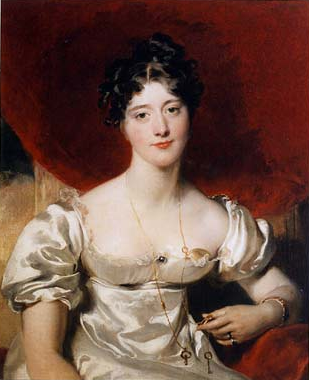Related Research Articles

Marquess of Londonderry, of the County of Londonderry, is a title in the Peerage of Ireland.

Charles William Vane, 3rd Marquess of Londonderry, was an Anglo-Irish nobleman, a British soldier and a politician. He served in the French Revolutionary Wars, in the suppression of the Irish Rebellion of 1798, and in the Napoleonic wars. He excelled as a cavalry commander in the Peninsular War (1807–1814) under John Moore and Arthur Wellesley.
This is a list of people who have served as Lord Lieutenant of Durham.
Edward Charles Stewart Robert Vane-Tempest-Stewart, 8th Marquess of Londonderry,, styled Lord Stewart until 1915 and Viscount Castlereagh between 1915 and 1946, was a British peer and politician.

Old Durham is a hamlet in County Durham, in England. It is situated approximately 1 mile east of central Durham and south of Gilesgate.

Mount Stewart is a 19th-century house and garden in County Down, Northern Ireland, owned by the National Trust. Situated on the east shore of Strangford Lough, a few miles outside the town of Newtownards and near Greyabbey, it was the Irish seat of the Stewart family, Marquesses of Londonderry. Prominently associated with the 2nd Marquess, Robert Stewart, Viscount Castlereagh, Britain's Foreign Secretary at the Congress of Vienna and with the 7th Marquess, Charles Vane-Tempest-Stewart, the former Air Minister who at Mount Stewart attempted private diplomacy with Hitler's Germany, the house and its contents reflect the history of the family's leading role in social and political life in Britain and Ireland.

George Henry Robert Charles William Vane-Tempest, 5th Marquess of Londonderry, KP, styled Viscount Seaham between 1823 and 1854 and known as The Earl Vane between 1854 and 1872, was a British aristocrat, businessman, diplomat and Conservative politician.

Wynyard, sometimes known as Wynyard Hall, is a large English country house near Stockton-on-Tees in County Durham. The house was the English family seat of the Vane-Tempest-Stewart family, Marquesses of Londonderry, an Anglo-Irish aristocratic dynasty, until it was sold to Sir John Hall in 1987.
Alexander Charles Robert "Alastair" Vane-Tempest-Stewart, 9th Marquess of Londonderry was a British nobleman.

Sir Henry Vane-Tempest, 2nd Baronet was a British politician. In early life his name was Henry Vane. He changed his name to Vane-Tempest when he inherited from his uncle John Tempest, Jr. in 1793.
John Tempest Jr. was a County Durham landowner and Tory politician who sat in the House of Commons from 1768 to 1794.
John Tempest was an English politician, elected as the first Member of Parliament for the County of Durham on 21 June 1675.
William Tempest was a Member of Parliament and a member of the Tempest family of Old Durham. The son of John Tempest and Elizabeth, the sole heiress of John Heath, he represented the City of Durham as Member of Parliament in 1678, 1680 and 1689. He was a defeated candidate in the elections of 1675,1679 and 1688.

The Tempest family was an English recusant family that originated in western Yorkshire in the 12th century.

Frances Anne Vane, Marchioness of Londonderry was a wealthy Anglo-Irish heiress and noblewoman. She was the daughter of Sir Henry Vane-Tempest, 2nd Baronet. She married Charles William Stewart, 1st Baron Stewart. She became a marchioness in 1822 when Charles succeeded his half-brother as 3rd Marquess of Londonderry.

Charles Stewart Vane-Tempest-Stewart, 6th Marquess of Londonderry,, styled Viscount Castlereagh between 1872 and 1884, was a British Conservative politician, landowner and benefactor, who served in various capacities in the Conservative administrations of the late 19th and early 20th centuries. After succeeding his father in the marquessate in 1884, he was Lord-Lieutenant of Ireland between 1886 and 1889. He later held office as Postmaster General between 1900 and 1902 and as President of the Board of Education between 1902 and 1905. A supporter of the Protestant causes in Ulster, he was an opponent of Irish Home Rule and one of the instigators of the formal alliance between the Conservative Party and the Liberal Unionists in 1893.

The Vane, later Vane-Tempest Baronetcy, of Long Newton in the County of Durham, was a title in the Baronetage of Great Britain. The Vane baronetcy was created on 13 July 1782 for Reverend Henry Vane, D.D., second son of George Vane of Long Newton. He was a descendant of Sir Henry Vane the Elder. Vane married Frances Tempest, daughter of John Tempest of Sherburne, Durham. When her brother, John Tempest Sr., died in 1771 naming the baronet's son as his heir, the younger Vane assumed by Royal licence the additional surname of Tempest in accordance with his uncle's will. Thus, when the 1st baronet died in 1794, his son became Baronet Vane-Tempest. This second baronet represented both the city and county of Durham in Parliament and was a well-known sportsman. He married Anne MacDonnell, 2nd Countess of Antrim. They had one child Lady Frances Anne, who married Lord Charles Stewart, later 3rd Marquess of Londonderry, who assumed the surname of Vane and in 1823 was named Earl Vane and Viscount Seaham. When Vane-Tempest died in 1813, the baronetcy became extinct.

Hambletonian, was one of the best Thoroughbred racehorses of the late 18th century, having won all of his race starts, except one, and was later a good sire. His victories included two Doncaster Cups in the late 1790s and the St. Leger Stakes at Doncaster in 1795.
Captain Sir Thomas Liddell, 1st Baronet (1578–1652) was an English politician, a member of the Liddell family which monopolized the local government of the North of England during the 16th and 17th centuries. He was one of the leading supporters of the Royalist cause in the English Civil War.
William Russell (1734–1817) was an English merchant, coal-fitter and banker. He first went into business as a merchant in Sunderland. He then made a substantial personal fortune from coal mining.